When I try to plot a graph, all my x axis values are overlaying on each other.
cdf <- ggplot(meltedData2, aes(x=id,group=1))+geom_line(aes(y=value,colour=variable),stat="identity")
cdf <- cdf + labs(x=xAxis, y=yAxis, title=title, ps=30)+scale_x_discrete(limits=id)
When I inserted the pretty breaks, I See half of the x axis values are missing
cdf <- cdf + labs(x=xAxis, y=yAxis, title=title, ps=30)+scale_x_discrete(limits=id, breaks=pretty_breaks())
I am looking for grouping of these x axis values automatically without overlaying on each other. Any help would be appreciated.
Here is the sample data
rates<-data.frame(rates)
id <- rownames(rates)
rates <- cbind(id=id, rates)
meltedData2 <- melt(rates,id.vars="id", na.rm = TRUE)
print(meltedData2)
id variable value
1 1 run1 0.13661202
2 2 run1 0.54788419
3 3 run1 0.60124611
4 4 run1 0.58677686
5 5 run1 0.58219178
6 6 run1 0.66757493
7 7 run1 0.54103343
...........................
...........................
541 266 run2 0.61267606
542 267 run2 0.45714286
543 268 run2 0.53066038
544 269 run2 0.56542056
545 270 run2 0.55744681
546 271 run2 0.58429119
547 272 run2 0.55922330
548 273 run2 0.63581489
549 274 run2 0.57789855
550 275 run2 0.57085828
dput(head(rates))
structure(list(id = structure(c(1L, 112L, 199L, 210L, 221L, 232L
), .Label = c("1", "10", "100", "101", "102", "103", "104", "105",
"106", "107", "108", "109", "11", "110", "111", "112", "113",
"114", "115", "116", "117", "118", "119", "12", "120", "121",
"122", "123", "124", "125", "126", "127", "128", "129", "13",
"130", "131", "132", "133", "134", "135", "136", "137", "138",
"139", "14", "140", "141", "142", "143", "144", "145", "146",
"147", "148", "149", "15", "150", "151", "152", "153", "154",
"155", "156", "157", "158", "159", "16", "160", "161", "162",
"163", "164", "165", "166", "167", "168", "169", "17", "170",
"171", "172", "173", "174", "175", "176", "177", "178", "179",
"18", "180", "181", "182", "183", "184", "185", "186", "187",
"188", "189", "19", "190", "191", "192", "193", "194", "195",
"196", "197", "198", "199", "2", "20", "200", "201", "202", "203",
"204", "205", "206", "207", "208", "209", "21", "210", "211",
"212", "213", "214", "215", "216", "217", "218", "219", "22",
"220", "221", "222", "223", "224", "225", "226", "227", "228",
"229", "23", "230", "231", "232", "233", "234", "235", "236",
"237", "238", "239", "24", "240", "241", "242", "243", "244",
"245", "246", "247", "248", "249", "25", "250", "251", "252",
"253", "254", "255", "256", "257", "258", "259", "26", "260",
"261", "262", "263", "264", "265", "266", "267", "268", "269",
"27", "270", "271", "272", "273", "274", "275", "28", "29", "3",
"30", "31", "32", "33", "34", "35", "36", "37", "38", "39", "4",
"40", "41", "42", "43", "44", "45", "46", "47", "48", "49", "5",
"50", "51", "52", "53", "54", "55", "56", "57", "58", "59", "6",
"60", "61", "62", "63", "64", "65", "66", "67", "68", "69", "7",
"70", "71", "72", "73", "74", "75", "76", "77", "78", "79", "8",
"80", "81", "82", "83", "84", "85", "86", "87", "88", "89", "9",
"90", "91", "92", "93", "94", "95", "96", "97", "98", "99"), class = "factor"),
run1 = c(0.136612021857924, 0.547884187082405, 0.601246105919003,
0.586776859504132, 0.582191780821918, 0.667574931880109),
run2 = c(0.136612021857924, 0.547884187082405, 0.601246105919003,
0.586776859504132, 0.582191780821918, 0.667574931880109)), .Names = c("id",
"run1", "run2"), row.names = c(NA, 6L), class = "data.frame")
dput(head(meltedData2))
structure(list(id = structure(c(1L, 112L, 199L, 210L, 221L, 232L
), .Label = c("1", "10", "100", "101", "102", "103", "104", "105",
"106", "107", "108", "109", "11", "110", "111", "112", "113",
"114", "115", "116", "117", "118", "119", "12", "120", "121",
"122", "123", "124", "125", "126", "127", "128", "129", "13",
"130", "131", "132", "133", "134", "135", "136", "137", "138",
"139", "14", "140", "141", "142", "143", "144", "145", "146",
"147", "148", "149", "15", "150", "151", "152", "153", "154",
"155", "156", "157", "158", "159", "16", "160", "161", "162",
"163", "164", "165", "166", "167", "168", "169", "17", "170",
"171", "172", "173", "174", "175", "176", "177", "178", "179",
"18", "180", "181", "182", "183", "184", "185", "186", "187",
"188", "189", "19", "190", "191", "192", "193", "194", "195",
"196", "197", "198", "199", "2", "20", "200", "201", "202", "203",
"204", "205", "206", "207", "208", "209", "21", "210", "211",
"212", "213", "214", "215", "216", "217", "218", "219", "22",
"220", "221", "222", "223", "224", "225", "226", "227", "228",
"229", "23", "230", "231", "232", "233", "234", "235", "236",
"237", "238", "239", "24", "240", "241", "242", "243", "244",
"245", "246", "247", "248", "249", "25", "250", "251", "252",
"253", "254", "255", "256", "257", "258", "259", "26", "260",
"261", "262", "263", "264", "265", "266", "267", "268", "269",
"27", "270", "271", "272", "273", "274", "275", "28", "29", "3",
"30", "31", "32", "33", "34", "35", "36", "37", "38", "39", "4",
"40", "41", "42", "43", "44", "45", "46", "47", "48", "49", "5",
"50", "51", "52", "53", "54", "55", "56", "57", "58", "59", "6",
"60", "61", "62", "63", "64", "65", "66", "67", "68", "69", "7",
"70", "71", "72", "73", "74", "75", "76", "77", "78", "79", "8",
"80", "81", "82", "83", "84", "85", "86", "87", "88", "89", "9",
"90", "91", "92", "93", "94", "95", "96", "97", "98", "99"), class = "factor"),
variable = structure(c(1L, 1L, 1L, 1L, 1L, 1L), .Label = c("run1",
"run2"), class = "factor"), value = c(0.136612021857924,
0.547884187082405, 0.601246105919003, 0.586776859504132,
0.582191780821918, 0.667574931880109)), .Names = c("id",
"variable", "value"), row.names = c(NA, 6L), class = "data.frame")

